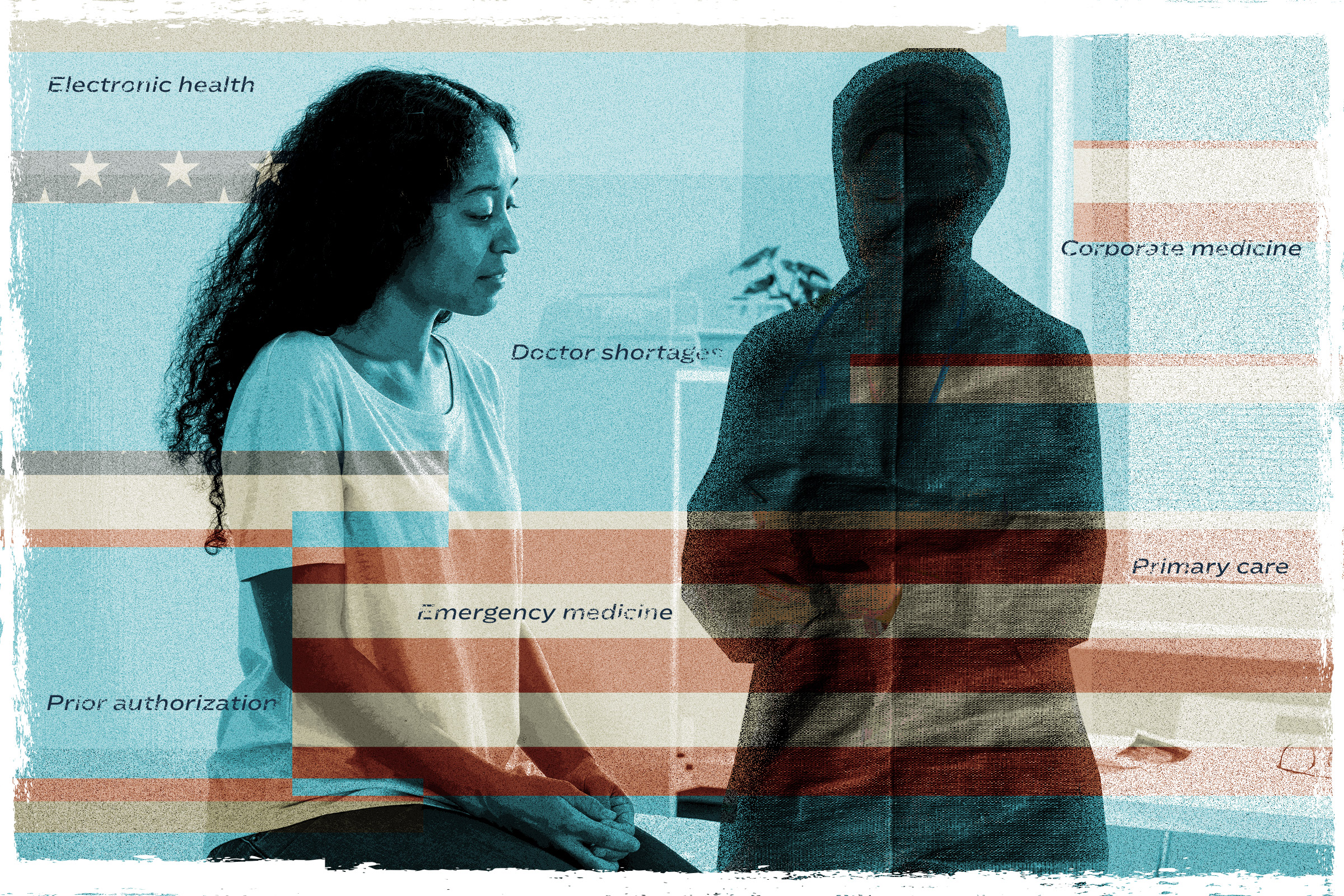Problems securing appointments to see doctors in the United States are exacerbated by soaring health care demand and fewer doctors. Many specializations are increasingly affected by this trend, but primary care and emergency medicine are among the hardest hit.
Consequently, many patients leave before being seen by doctors.
One study analyzed more than 1,000 hospitals between 2017 and the end of 2021 and found that those with the worst performance had 4.4 percent of emergency room patients leave before a medical evaluation was conducted. At the end of 2021, that number had risen to more than 10 percent.
Compounding the issue is that nearly half of the doctor population will reach retirement age within the next 10 years and career burnout is hitting the rest harder than ever, according to data from the Association of American Medical Colleges.
Almost 50 percent of doctors report that they feel burned out, according to a 2024 Medscape report.
“This is definitely coming down the pipeline.” emergency physician Dr. Jared Ross told The Epoch Times. “It’s been coming for a long time, and we’re seeing this all across health care.”
Dr. Ross is also president of Missouri-based Emergency Medical Services, Education, and Consulting. He’s watched the United States’ health care worker crisis unfold on the front lines and said the shortage of physicians is an old problem that’s reached a tipping point.
“We’ve talked about this for years. It’s nothing new. There’s been a number of attempted stopgap measures that haven’t been all that successful,” he said.

These provisional solutions include bringing in more practitioners from foreign countries, introducing medical school loan forgiveness programs, expanding telehealth services, and increasing the number of resident physician training supported by Medicare.
Dr. Ross said he has seen doctor shortages affect emergency medicine but noted that primary care has “really struggled” to retain physicians.
The other reason is what Dr. Ross called the “corporatization of medicine.”
“The problem is we have an insurance system that is a massive bureaucracy,” he said.
Dr. Ross said that at a recent conference with other medical leaders, it was discussed that the United States has “really pushed away from the model of traditional health care.”
There was a general consensus within the group that insurance companies have become too powerful in medicine, he said.
“The administrative burden or hassle, as many doctors describe it, is very disheartening,” Dr. William Schaffner, an infectious disease specialist at the Vanderbilt University Medical Center, told The Epoch Times.
Having worked in medicine for more than 40 years, Dr. Schaffner has witnessed it evolve into something “aggressively more complicated” as insurance companies expand power over doctors. He said this trend became more noticeable by the 1990s.
“Doctors didn’t go to medical school in anticipation of arguing with insurance companies. It’s depressing and discouraging,” Dr. Schaffner said.

Battling With Insurance
The move from independent practice to medical group employee presents its own issues. Aside from increased patient loads, it has left doctors at the mercy of having to get prior approval from insurance companies to carry out medical treatments and procedures.This forces a quantity-over-quality approach to treatment, according to Dr. Ross.
Prior authorizations are “an absolute headache,” he said. Physicians are now stuck battling with a third party who creates “as many roadblocks as possible because they don’t want to pay out.”
Dr. Schaffner said it took “numerous telephone conversations” with an insurance provider for a family member to get a necessary medical procedure done.
He said part of why it’s challenging is that there needs to be a level of trust on the insurance company’s end. “It’s not just a formal relationship that happens, but there also has to be a trust that develops with the benefits manager. It can take time,” Dr. Schaffner said.

Beyond fueling the upward trend of doctor burnout, there are also concerns about clinical outcomes for patients because of lengthy prior authorizations. Eighty-nine percent of doctors reported either a “somewhat” or “significant” negative effect on their patient outcomes.
Dr. Ross said he believes that the overarching bureaucracy in medicine is a major component of physician burnout, but there’s also what he called the “documentation burden.”
Filling out electronic health records eats up hours of a physician’s day. Much of this record-keeping is devoted to billing, which is a source of frustration for many health care practitioners. One study showed that primary care physicians spend a median 36.2 minutes per patient working with electronic health records.
It also significantly reduces the amount of time a doctor can spend treating or educating patients about their conditions.
Moreover, Dr. Ross said many doctors have no choice but to bring their work home with them at the end of the day. “They’re seeing patients during the day and writing notes after hours when they’re home with their families,” he said.

“Medical records have given us a lot of wonderful things. The idea was it would make things faster, but it’s not. We used just to scribble some notes in a folder, but now we’re expected to write a whole diatribe. Information is being constantly added from government and insurance providers ... electronic records have given us access to more information, but it’s also become overcomplicated and less efficient.”
Dr. Schaffner concurred, saying insurance companies have created a “time sink” with the added documentation. Many doctors maintain that electronic health records are too focused on billing and not on the patient’s condition.
Consequently, the medical scribe industry has sprung up alongside the growing paperwork burden for doctors, but it’s an added expense for physicians already struggling with rising industry costs. A medical scribe will take the doctor’s recorded audio notes for a patient and transcribe them, saving time for the doctor.
“There are only 24 hours a day. You can either be on your computer documenting a patient or you can be seeing the next patient,” Dr. Schaffner said.
One study by the AMA linked medical scribes to a 27 percent lower physician burnout rate among primary care providers.
Patient Care Effects
In 2023, nearly 30 percent of medical groups had at least one physician leave or retire early because of burnout, according to a survey by the Medical Group Management Association.
Many health care professionals are sounding the alarm over the future of patient care.
“We’re already seeing this,” Dr. Ross said. “We have huge waits for primary care doctors. This is especially true in inner city and rural settings.”
Dr. Ross said that means many simply head to urgent care or the emergency room.
“What we’re doing at the end of the day is asking non-medical people to make a decision on where to get care,” he said.
Dr. Schaffner said he has observed that because of rising levels of career burnout, the younger generation of physicians is beginning to limit their working hours. He said new physicians are more keenly aware of “professional life balance” and are much less likely to be on call.
“They want to do burnout prevention,” he said.

Although this may keep more doctors from leaving their fields, it still poses a problem from a patient accessibility standpoint.
This is becoming an urgent issue in the United States’ aging and chronically sick population. Six in 10 adults in the United States have a chronic disease, according to the Centers for Disease Control and Prevention. Four in 10 have two or more.
And a little more than 17 percent of the population is older than 65, data from the Census Bureau indicate. That number is expected to surpass 20 percent by 2040.
The rules of corporate medicine aren’t making this problem any easier, Dr. Ross said. The “revenue value unit” is now the standard method of evaluating physician productivity.
“Physicians really feel like cogs in a wheel. They’re evaluated on their production. How much are they billing? How much [money] are they bringing in for their practice? Not so much the quality of care or patient satisfaction,” Dr. Ross said.
In a 2023 J.D. Power satisfaction survey of overnight hospital patients, only 36 percent said they were able to speak with a doctor when needed—down from 43 percent in the 2011 survey.
“It all comes back to what medicine has become,” Dr. Ross said.















